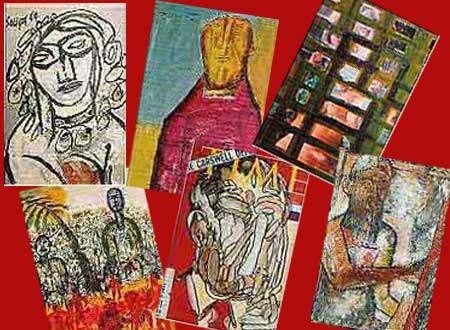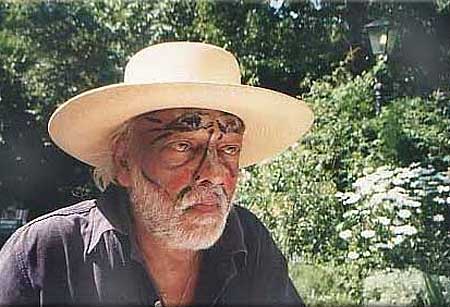Photographs: Tim Wimborne/Reuters
If it is true that roughly only a tenth of an artist's output would qualify as his best -- this is a widely held approximation -- then how do you arrive at which works deserve to be in that select category?
Why is it that an artist's work can vary so greatly that values can range from the humdrum average (in a manner of speaking) to the extortionately phenomenal?
The caveat is that there is no authority in the world that can look at any painting out of context and declare it to be a work of rare, or great, aesthetic or collectible value.
To do that, you have to spend a great deal of time studying an artist, his influences, how he stayed, or strayed, from a particular series of works, and so on.
Text: Kishore Singh, Business Standard
What makes a painting valuable?
Image: A collage of paintings by F N SouzaPhotographs: www.fnsouza.com/
This is why it is important to study an artist as much as his art.
We need to understand why Ram Kumar, now best known for his abstract landscapes, worked on, and later deviated from, doing landscapes of Benares that first drew the attention of collectors; or why Krishen Khanna spent so much energy painting the people who make up India's streetscapes, and more particularly the bandwallahs; or why the prostitute crops up so frequently in Sunil Das's work.
Having understood each phase of an artist's life, it will not be difficult to figure out which period was more important, in which phase he painted his best, and which specific works within that are the highlight of the series.
Of course, some judgements can be at least emotional (or at least subjective), but most art observers will agree that no matter how much they argue about an artist's pedigree, they will likely agree on his best works, even though the ranking order might vary.
What makes a painting valuable?
Image: Painter F N SouzaPhotographs: www.fnsouza.com/
Nothing illustrates this better than F N Souza's Birth which was bought last year by Tina Ambani for Rs 10.6 crore (Rs 106 million).
Even by Souza's standards, that was an extraordinarily high amount to pay for a painting. Why did Birth fetch a record price for both the artist as well as for Indian art?
To understand that, you must know a little about Souza, born in Saligao, Goa, where his father died soon after his own birth, and his elder sister soon after, leaving him to be brought up by his seamstress mother first in Goa and later in Mumbai.
Souza was not a model student, and rebelled against church and authority, drew pornographic pictures in the school toilets, and was expelled from the JJ College of Art for replacing the Union Jack with the Indian tricolor before the country's independence.
Some of these rebellions would stay the course of his life in London, Paris and New York, even though -- and unlike many of his peers -- he found success with his first major show in London.
What makes a painting valuable?
Image: A worker cleans up at the bottom of paintings by Pablo Ruiz PicassoPhotographs: Charles Platiau/Reuters
But in London, as in Paris, he was abjured as much for his art as his wild ways, became an alcoholic, but refused to paint any differently, though in his later years he reformed sufficiently to become a teetotaler.
Souza's oeuvre consists of a few recurring images. The first of these are the nudes. Collectors believe -- not wrongly either -- that he painted unflattering images of the prostitutes in London, though he wasn't entirely wary of painting nudes of those close to his life.
He confessed to being a voyeur, and as a boy growing up he would watch his mother at her bath through a peephole, and later her clients when they came to be measured for dresses, or when they would try them on, as a result of which he was familiar with the contours of the female body.
What makes a painting valuable?
Image: A worker adjusts a painting by Belgian artist Rene MagrittePhotographs: Francois Lenoir/Reuters
Souza greatly admired Pablo Picasso, and the Cubists, and these influences can be seen somewhat in his nudes, but more noticeably in his landscapes, which tended to address Western skylines, and would often include a church, for religion played a great part in his upbringing as well as in his painting.
Too often, though, the bigotry, greed and iconography that he painted questioned rather than reassured viewers with regard to religion.
Souza was also fond of still life studies, often doing impressionistic renderings of vases and flowers and fruits and bowls. And self-portraits -- where he would practice distortion most effectively -- were to remain a favourite.
What makes a painting valuable?
Image: A visitors looks at a painting by Spanish artist Pablo Ruiz PicassoPhotographs: Charles Platiau/Reuters
Birth, painted in 1955, is a valuable work because it contains at least four of his favourite themes.
It is also something that was close to his life, since it is believed that it depicts his wife of that period, Maria, in labour.
Though there is no overt reference to religion, this could be Madonna giving birth to the Baby Jesus, and there is a hint that at least one of the buildings in the background could be a church.
Be that as it may, you cannot escape the other features: The nude in a state of labour being consoled by the artist, while in the background there is the familiar London landscape as well as his trademark still life of jars and vases.
Any wonder the work is considered vintage Souza?







article